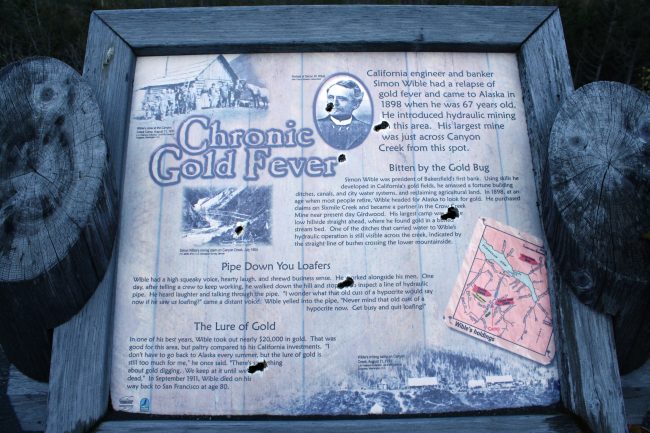
One of two bullet-riddled roadside signs along the Seward Highway, depicting the early 20th century mining exploits of Simon Wible.
By Clark Fair
Today, the average dump truck hauls about 10 cubic yards of gravel every time it roars out of the pit.
Early in the first decade of the 20th century, when the Tyee Mining Company’s placer operation on Canyon Creek was at its peak, it was processing up to 1,000 cubic yards of gravel each day in its search for gold. That’s the equivalent of 100 dump truck loads every day. And those miners had no trucks.
Although the Seward Highway now descends the west bank of Canyon Creek from Summit Lake to the Hope Highway, this tremendous outburst of mining production occurred before there were highways. In fact, there were only a few wagon roads. Mostly, there were trails, many of them difficult to navigate because of the rocky, uneven terrain and the numerous streams tumbling across them out of the mountains.
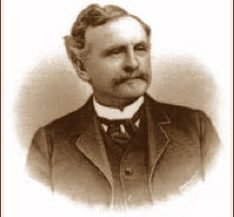
Simon William Wible.
Visitors to this area today can pull their own motorized vehicles into a small turnout at about Milepost 54, gaze across the canyon at the site of the old mining camp, and read two informative (albeit bullet-riddled) signs that discuss the placer operation and the man most responsible for its success—Simon William Wible.
Simon Wible, who was born in Pennsylvania in 1832, was a visionary rich man with the skill and knowledge necessary to turn big ideas into reality—and into profits. Due partly to Wible’s innovations, Canyon Creek in the early 1900s was the major gold-producing stream in the Turnagain Arm Mining District. Historically, its production in the district was second only to Crow Creek near Girdwood.
Decades before heading north to Alaska, Wible had set his sights westward on the gold rush that began in California in 1849. According to Mary Barry’s A History of Mining on the Kenai Peninsula, Alaska, and the Alaska Mining Hall of Fame Foundation website, Wible crossed the Great Plains in 1852 with a man named Pilcher and Pilcher’s son, Ben, who would go on to work for Wible for 45 years as his chief assistant and mining superintendent.
In California, Wible became an engineer who succeeded in the mining business and also as the designer of irrigation projects for cattle barons. He earned enough money to help found the Bank of Bakersfield and eventually become its majority stockholder and president.
Then, at age 66 and about 45 years after coming to California, he “had a relapse of gold fever,” according to the roadside signs, and decided to try prospecting in Alaska. In 1898, he packed his bags—including his money bags, apparently—and headed north.
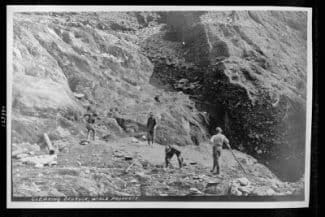
Mining the gravels high above the creek bed.
His first mining venture in Alaska involved the installation of a hydraulic mining elevator on a claim at Sixmile Creek, but in the spring of 1899 he began investing. Over the winter, he had befriended Charles Brooks, a lawyer in the mining town of Sunrise, and from Brooks he purchased his share in the Crow Creek mining venture.
Wible worked alongside his crew of men, and Mary Barry recalls that he had a high squeaky voice that was, nevertheless, the voice of authority. Once, after telling his men to keep working, he moved downhill to inspect some pipes, and one of the men, who had no idea that his voice would carry from his end of the pipe to Wible’s location, said, “I wonder what that old cuss of a hypocrite would say now if he could see us loafing.” Wible wasted no time in his response, yelling into the pipe, “Never mind that old cuss of a hypocrite now! Get busy and quit loafing!”
According to Barry, Wible purchased his first Canyon Creek claim later in 1899 from Albert Weldon (“Jack”) Morgan, but Morgan himself contradicts that notion in his own book, Memories of Old Sunrise. Morgan said that he worked for Wible on Canyon Creek, but that the claim was purchased from a miner named Kingsley Smith.
What Wible did with this claim and all the subsequent claims he acquired on Canyon Creek was most impressive, especially compared to the shovel-and-pick grunt work being done by other Canyon Creek miners working the stream bottom. Except for a crew working an area called The Forks, most miners worked between the narrow canyon walls and against the swift current of the stream in a sometimes dangerous struggle for riches.
According to information gathered in Cultural Resources Survey of the Seward Highway, Milepost 50-65.5, Kenai Peninsula, Alaska, by Rolfe G. Buzzell and J. David McMahan, Wible employed his engineering skills and his banknotes to create a series of ponds and ditches to power a hydraulic mining system unlike anything seen at that time in the district and probably unrivaled for years.
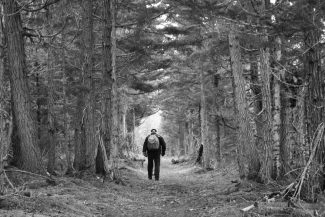
Walking the old wagon road through the hemlocks near Wible’s Canyon Creek claim.
Canyon Creek runs roughly south to north until it joins East Fork Creek and becomes Sixmile Creek, just below the modern-day Canyon Creek bridge. Wible’s main operation was located on the high rocky benches approximately three miles upstream from this confluence.
To reach and haul heavy equipment into what became known as the Wible Mining Camp, Wible had a road built up the east bank to his claim. His ambitious plan called for diverting water flowing out of the mountains even further upstream, then channeling that water across the mountainsides, and dumping it into deep holding ponds that would be used to power a hydraulic mining system.
He then planned to construct a four-foot-wide, two-foot-deep ditch (later called the Lower Wible Ditch) descending from the lower pond into the canyon. The ditch would feed into a steadily narrowing series of pipes that would produce a pressurized spray that could be used to blast away layers of gravel and expose ore-bearing sediments. A nozzle (called a “monitor”) at the end of this system (called a “hydraulic giant”) would allow him to direct a stream of water powerful enough to roll small boulders.
In order to get the water he needed to run this system, Wible directed his men to build two holding ponds, the lower pond sitting directly below his camp, which consisted of a cluster of log buildings on a ridgeline between the mountains and the canyon.
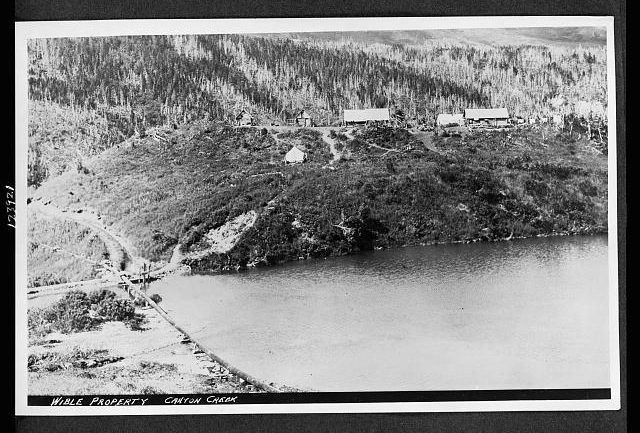
The holding pond directly below Wible’s mining camp. Note the Lower Wible Ditch at the far left.
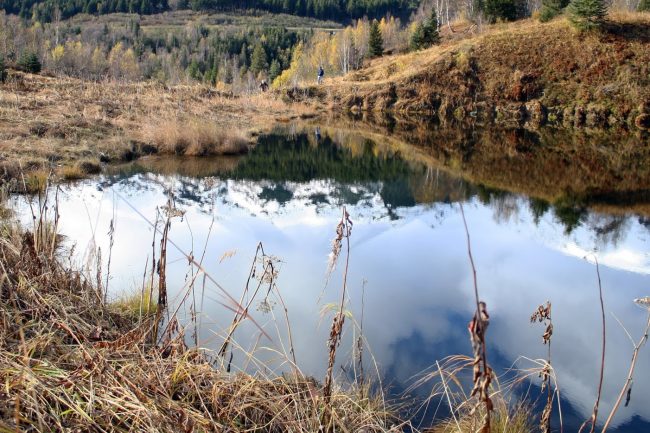
The same holding pond in 2011. The Seward Highway, which did not exist when the previous photo was taken, can be seen in the background here across the Canyon Creek drainage.
Next, they began the years-long process of building what became known as the Upper Wible Ditch. Six feet wide at the top and tapering to three feet wide at the bottom, three feet deep, and eventually four miles long, the upper ditch stretched upstream along the mountainside all the way to Moose and Roaring creeks. According to Buzzell and McMahan, Wible actually contemplated running his ditch an additional 12 miles upstream, all the way to Lower Summit Lake, but changed his mind probably because of the high incidence of destructive snow slides along those mountainsides.
In addition to these ditches and ponds, he also built flumes and tunnels to divert water, and he brought in heavy machinery, such as a 900-pound pelton wheel to provide power to a hoist for the lifting of especially heavy boulders.
What Wible realized first among miners on Canyon Creek, said Buzzell and McMahan, was that in the bench deposits about 100 feet above the Canyon Creek stream bed were “pre-glacial stream beds with rich gold deposits that had been covered by glacial deposits.” One horseshoe-shaped deposit he discovered turned out to be particularly rich.
And his hydraulic mining operation was perfect for blasting apart these sediments and draining them into an elaborate system of sluice boxes that could separate out the gold, while dumping all his tailings conveniently right into the creek.
Jack Morgan called Wible “a real miner,” a strong statement from a man living among hundreds of other men toiling for gold.
Wible, who traveled back to his California financial interests every winter, died at age 79 as he was returning to the port of San Francisco in 1911. He left much of his Canyon Creek interests to his long-time employee, Tom Allison, who continued to work the claims and live at the Wible Camp until the 1940s, when mining in the region was no longer profitable.
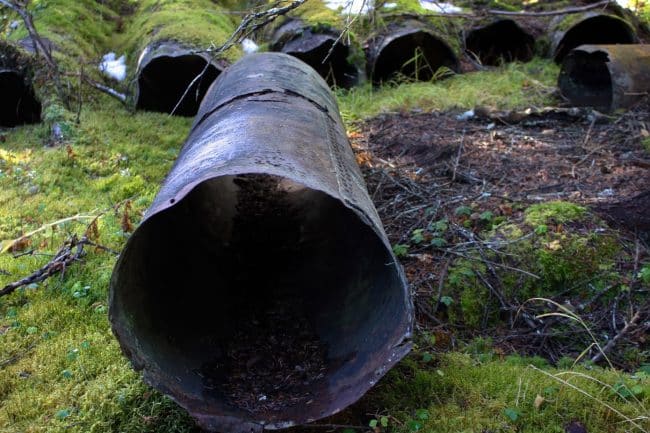 This article originally appeared on Clark Fair’s blog in 2011.
This article originally appeared on Clark Fair’s blog in 2011.
Enjoy these articles? Sign up for our monthly newsletter to be sure to see them or follow us on Facebook or Instagram. Sign up below!
 Clark Fair, a lifetime Alaskan now living in Homer, grew up on a homestead in the Soldotna area. He is a former high school English teacher and journalist who now does freelance writing and photography and works part time for Kenai Peninsula College.
Clark Fair, a lifetime Alaskan now living in Homer, grew up on a homestead in the Soldotna area. He is a former high school English teacher and journalist who now does freelance writing and photography and works part time for Kenai Peninsula College.
